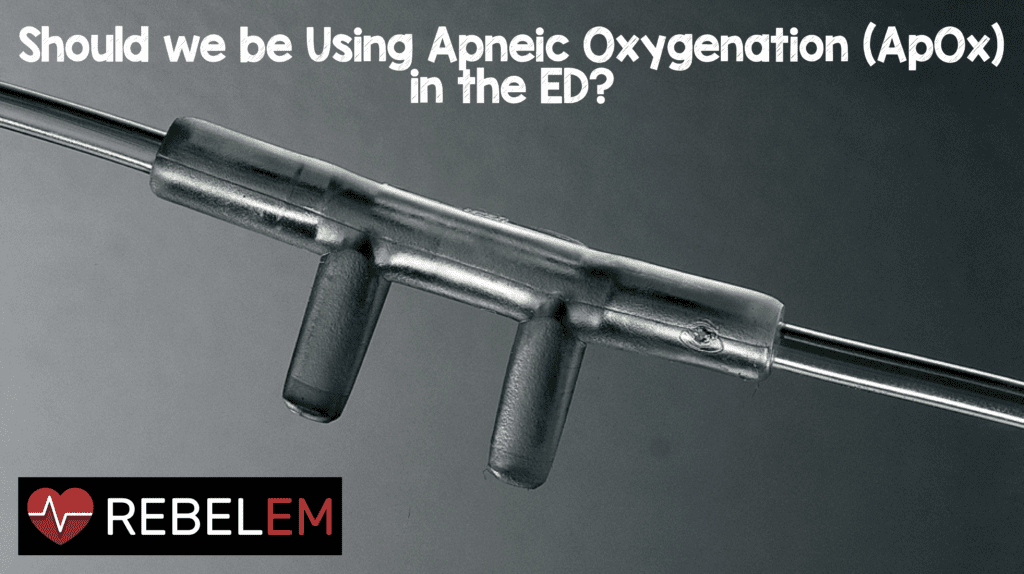

What Trial are we Discussing?
HOT OFF THE PRESS: Sackles JC et al. First Pass Success Without Hypoxemia is Increased with the Use of Apneic Oxygenation During RSI in the Emergency Department. Acad Emerg Med 2016. [epub ahead of print] PMID: 26836712
What They Did:
- Single Center, Observational trial to determine the effect of apneic oxygenation (ApOx) on first pass success without hypoxemia (FPS-H) in adult patients undergoing rapid sequence intubation (RSI) in the emergency department (ED).
- Performed a standard multivariate logistic regression analysis to evaluate association between ApOx and FPS-H
- Adult patients ≥18 years of age undergoing RSI in ED by EM Resident
Definitions:
- ApOx was performed by nasal cannula at an oxygen flow rate of 15L/min + a non-rebreather facemask at 15L/min for 3 minutes of preoxygenation before RSI drugs were administered (i.e. No Positive Pressure Ventilation during RSI, unless necessitated by hypoxemia)
- Intubation attempt = Insertion of the laryngoscope blade into the mouth of the patient, regardless whether an attempt was made to insert a tracheal tube
- First Pass Success = Successful tracheal intubation on a single laryngoscope insertion
- First Pass Success without Hypoxemia (FPS-H) = FPS without oxygen saturations falling below 90% during the intubation
Outcomes:
- Primary: First Pass Success without Hypoxemia (FPS-H)
Results:
- 635 patients met inclusion criteria
- 380 had ApOx
- 255 had no ApOx
- First Pass Success (FPS)
- ApOx: 342/380 (90.0%)
- No ApOx: 210/255 (82.4%)
- Difference = 7.6% (95%CI 2.1 – 13.2%)
- Hypoxemia in Patients with First Pass Success
- ApOx: 30/342 (8.8%)
- No ApOx: 34/210 (16.2%)
- Difference -7.4% (95% CI -13.2 – 1.6%)
- Overall Incidence of Hypoxemia:
- ApOx = 48/380 (12.6%)
- No ApOx = 51/255 (20%)
- Difference: -7.4% (95% CI -13.3 – -1.4%)
- FPS-H
- ApOx: 312/380 (82.1%)
- No ApOx: 176/255 (69.0%)
- Absolute Difference 13.1% (95% CI 6.2 – 19.9%)
- NNT = 7.6
- Multivariate Logistic Regression Analysis:
- Use of ApOx associated with increased odds of FPS-H = OR 2.2 (95% CI 1.5 – 3.3)
Strengths:
- Performed in an ED setting
Limitations:
- Time of preoxygenation before intubation was not formally timed, but rather based on the operator’s subjective estimation of time, which makes preoxygenation times very inaccurate
- Observational study, therefore only allowing association not causation of ApOx
- There was baseline characteristic differences between the cohorts with more trauma patients and more difficult airways in the No ApOx cohort which could falsely make ApOx look more beneficial than it really is
- There may also be unidentified confounders that the authors may not have been aware of that could have affected the results (i.e. Operators using ApOx could have been more skilled and conscientious)
- Oxygen saturations were documented by the operator after the intubation was completed, which could lead to inaccuracies in the dataset due to the self-reporting nature of the data collection
- A large number of patients had to be excluded due to missing oxygen saturation data (n = 143), and inclusion of these patients may have affected the results
- Majority of intubations performed by EM Residents and majority with video laryngoscopy, which may make generalizability of the results difficult in other EDs (i.e. Maybe ApOx less benefit to operators who are very skilled at laryngoscopy and can complete intubation very quickly).
Discussion:
- Despite encouraging the use of ApOx during the study period, it was only used in 60% of patients undergoing RSI in the ED. Also <1/3 used oxygen flow rate of 15L/min.
- Majority of patients were intubated for airway protection, not respiratory failure (Airway Protection = 74.7% ApOx and 76.9% No ApOx).
- The only RCT evaluating the effectiveness of ApOx (i.e. The FELLOW Trial) for emergent intubation found that ApOx had no benefit in reducing the incidence of hypoxemia. Over half the patient population required intubation for respiratory failure and almost 1/3 of them were on NIPPV prior to intubation.
- Factors that were associated with first pass success without hypoxemia included: use of video laryngoscopy, the more senior the operator (i.e. PGY3 EM Resident)
Author Conclusion: “The use of ApOx during the RSI of adult patients in the ED was associated with a significant increase in FPS-H. These results suggest that the use of ApOx has the potential to increase the safety of RSI in the ED by reducing the number of attempts and incidence of hypoxemia.”
Clinical Take Home Point: Use of ApOx during RSI in adult patients in the ED, is low cost, low complexity, and not proven to cause harm while also reducing incidence of hypoxemia and increasing first pass attempt intubation. It is time for a RCT evaluating this modality.
For More on This Topic Checkout:
- Minh Le Cong at PHARM: Pre-Hospital And Retrieval Medicine – PHARM Podcast 132 – Apneic Oxygenation in Emergency Intubations with Lead Author John Sakles
References:
- Sackles JC et al. First Pass Success Without Hypoxemia is Increased with the Use of Apneic Oxygenation During RSI in the Emergency Department. Acad Emerg Med 2016. [epub ahead of print] PMID: 26836712
Post Peer Reviewed By: Anand Swaminathan (Twitter: @EMSwami)
The post Should we be Using Apneic Oxygenation (ApOx) in the ED? appeared first on REBEL EM - Emergency Medicine Blog.
